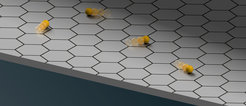Bosons confined in a flat land
Inherent two-dimensional behavior of Boson gas revealed in the honeycomb magnet YbCl3
A joint team of researchers from the Department of Quantum Materials (Takagi) at the Max Planck Institute for Solid State Research and the University of Tokyo has experimentally demonstrated for the first time the distinct behavior of an ideal two-dimensional (2D) dilute Bose gas using a quantum magnet.

Particles in this world are classified into either ‘fermions’ or ‘bosons’, depending on their quantum statistical nature, which becomes prominent in the low temperatures. While fermions cannot occupy a single quantum state, multiple bosons can be accommodated in one quantum state. At low-temperatures, such a characteristic of bosons leads to an intriguing phenomenon known as the Bose-Einstein condensation (BEC), where a macroscopic number of bosons fall into a single ground state and behave as a condensate that can be described by a macroscopic wave function. This was first predicted theoretically by Satyendra Nath Bose and Albert Einstein, and it was later identified in superfluid helium, dilute atomic gases as real examples.
Interestingly, certain types of magnets, Heisenberg and XY magnets, near the saturation magnetic field can be viewed as an ensemble of dilute bosons with hard-core interactions. Here, the deviation of the magnetization from its saturation value represents the number of bosons, and the ordering of the magnetic degrees of freedom perpendicular to the magnetic field (the XY component) corresponds to a BEC. What is unique here is that we can precisely tune the boson density just by changing the magnetic field and investigate the property of dilute bosons in the low temperature limit on the verge of BEC. Such bosons are governed by strong fluctuations between the two different states, namely, the BEC of finite number of bosons and a vacuum (a state with no bosons). These fluctuations, which exist even at absolute zero temperature, originate from the uncertainty principle of quantum mechanics and are called quantum critical fluctuations.
What happens if we confine those bosons in an ideal two-dimensional (2D) space? Interestingly, the property of bosons significantly changes depending on the spatial dimension. In the pure 2D case, bosons cannot form a true condensate and, instead, turn to an exotic quasi-condensate through a topological phase transition described by the dissociation of vortex pairs, known as the Berezinskii-Kosterlitz-Thouless (BKT) transition. Moreover, the effective hard-core interaction between bosons vanishes in the dilute limit with the logarithmic correction ln <n> characteristic to 2D, where <n> is the boson density. Can we demonstrate these distinct features using real magnets? Unfortunately, this has never been done. We need an ideal model system, a stack of ideal 2D magnets connected through extremely tiny interlayer coupling. In addition, the saturation field should be small enough to make detailed thermodynamic/thermal transport studies.
In this work, the international research team experimentally clarified for the first time the unique 2D behavior of a dilute boson gas using the honeycomb Heisenberg magnetic material YbCl3. This material has recently attracted much attention as a candidate for the Kitaev quantum spin liquid, but more recent studies have revealed that it is a nearly pure 2D Heisenberg magnet with in-plane interactions of 5 K and interlayer interactions about five orders of magnitude smaller than this. The saturation field is relatively small, about 6 T in the in-plane direction, which makes high-precision thermodynamics and thermal transport measurements around this field possible. The team found thermodynamic properties, specific heat and magnetization, at the saturation magnetic field are surprisingly well described as a 2D Bose gas in the dilute limit. Furthermore the boson-boson repulsion in the quantum critical 2D Bose gas takes a considerably small value, at least one order of magnitude smaller than those found in its 3D analogues, which evidences the presence the logarithmic correction ln <n> unique to 2D. With boson doping, decreasing the magnetic field from the saturation field, the quantum critical 2D Bose gas was found to experience a 3D BEC, marginally produced by an extremely small interlayer coupling (three-dimensionality). The demonstration of such a distinct 2D nature of Bose gas establishes YbCl3 as a unique playground of further explorations for novel phenomena of 2D Bose gas.
